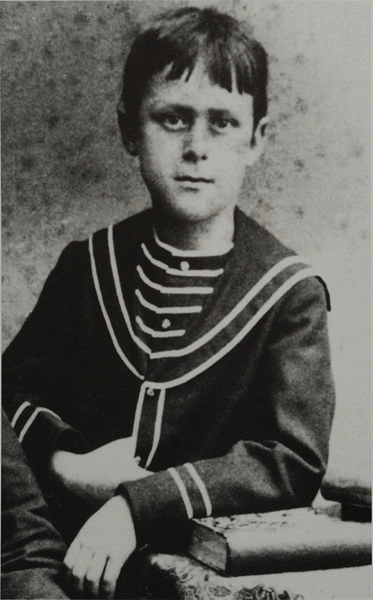Thomas Mann, Death in Venice
From Eliot's mincing and self-conscious hero Prufrock we move to Mann's Gustav Von Aschenbach, who may share quite a bit with Eliot's protagonist. Aschenbach may, despite seeming over-conscious
of his life as lived, may be guilty of a similar unwillingness to "dare" as Prufrock.
To some extent we move back into Romanticism with this kind of heroic, yet
flawed, character. There is here, for instance, an epic battle between reason
and passion.
Thomas Mann (1875-1955)
Born of a well-known and prosperous burger (bourgeois) family
Sees a sharp contrast between the “type” of northern person and
the “southern” (the latter bringing itself into his own bloodlines
in the figure of his mother, a Portugeuse Creole woman from Rio de Janiero).
Read widely in European literature (British, French, Russian, etc.) Favorite
novelist—Tolstoy.
After Germany’s defeat in WWI, he spoke in favor of an idealist, irrational,
Wagnerian nationalism. Seeing the rise of Hitler, spoke out in favor of democracy,
then against Hitler and the Nazi’s.
Left Germany in 1934 when Hitler came to power. Exile first in the U.S., then
in Europe.
Two sisters and one son committed suicide.
Major Works
Buddenbrooks (1901)—Epic family saga with which he made his name.
The Magic Mountain (1924). Inmates at a health spa debate the state of the
world—between humanism and totalitarianism.
Joseph and His Brothers (1933-43)—suggests through Mann’s treatment
of the biblical legend the fate of exiles such as himself.
Doctor Faustus (1947)—an allegory of the descent of Germany into Nazi
barbarism.
Some aspects of Death in Venice (1912) that we will begin to discuss.
The influence of the great 19th century philosopher Friedrich
Nietzsche, especially his theory of art as expounded in The
Birth of Tragedy.
The prominence of “Art” in the text (in the conception of art
embraced by Aschenbach).
Mann’s parodistic style which allows us to conceive of the unreliable
central perspective of the novel. (In other words, are the theories of art,
etc., meant to be taken as coming from a perspective that is truly noble and
“heroic,” or is there a critique of this perspective throughout
the novel? Or, put another way, is the fawning praise of Aschenbach's achievements supposed to be sincere, or are they overstated, perhaps by an inner, approving voice of Gustav himself?)
The musical style of leitmotif (our glossary word for the day).
Another formative influence on the text—the death of Gustav
Mahler in 1911. |
|
Death in Venice. How to describe Aschenbach as we meet him in the very
beginning of the novel.
--he is embroiled in difficulties at work, which is the problem of forcing language
to yield to the precision which his kind of art demands of it.
--he is moving away from his work (his desk) and out into the city.
--perhaps the most consistent and accurate way to describe the writer is that
he is alone.
A look at a few specific passages.
I. The confrontation with "the other." Where does this happen? (in a cemetary). How does the man contrast with the introspective Von Aschenbach? Look at the qualities of the animal that still cling to the traveller.
II. Aschenbach's imaginary summoning of travel, the exotic. There is a tropical flavor commingled with suggestions of violence of the primaeval and of a risk undertaken. A kind of ideal of escape (compare with the real).
III. Assessments of the artistic temperment, the artistic sensibility. The seeming value put on pure passionate involvement, yet a kind of art of which Von A. is incapable.
IV. Chapter 2 is a profile of Gustav Von Aschenbach. It is the profile of the artist, of the tireless worker in the realm of letters, the man who has bent his will to conquer his slight frame and "endure," "despite" everything. Here is an interesting note--that it is only at the end of the chapter, after a painstaking account of his triumphs and his nature, that we get the physical description of our hero, launched into abruptly, almost as an afterthought.
The cemetery. The radiant mysticism of the scriptural quotations.
The most accurate definition of Aschenbach the definition of him as an artist.
We think of the Ilyich descent and the memories of childhood that invaded him—how
different was Aschenbach’s childhood! (44). What are the watchwords of
this artist? "Endure." "Discipline." And maybe most importantly,
“Despite” (45).
We even have a kind of heroism attached to the kind of modestly suffering intellect,
a title which Aschenbach takes on himself.
How does this kind of temperament live? Look at his walk. His status as a flaneur.
His disconcertedness before the gaze of the traveler. Then there is his reaction.
At once a kind of un-mastered product of the imagination, a return of the romantic
sublime, of the unknown, the traits of the abyss. Upon reflection, he retains
his resolve to travel, but. . .not all the way to the tigers.
One leitmotif is the appearance of certain guides or messengers (who seem to
come from the land of death). The stranger, (the traveller) in the cemetary the first appearance of a kind of "type" that is contrary to the type of man Aschenbach has willed himself to be.
In the end, we ask: how is the experience of confronting beauty in the real,
outside of the intellectual foraging in his “imagination,” beginning
to affect Von A?

